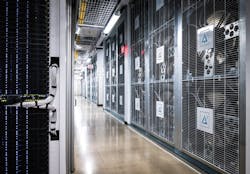Today and Tomorrow, Sustainable Data Centers Start With Design
Phill Lawson-Shanks, CIO and Sustainability Committee Chair at Aligned Energy hones in on sustainable data centers, and what a “new breed” of data centers focused on energy efficiency will look like.
Phill Lawson-Shanks, CIO and Sustainability Committee Chair, Aligned Energy
According to the Natural Resources Defense Council (NRDC), annual data center electricity consumption in the U.S. is projected to increase from 91 billion kilowatt-hours in 2013 to roughly 140 billion kilowatt-hours this year. To put a finer point on the latter figure, that’s the equivalent annual output of 50 power plants, causing nearly 150 million metric tons of carbon emissions.
Yes, there has been significant progress in data center efficiency and sustainability over the past decade, especially as evidenced by the ultra-efficient, hyperscale facilities run by the likes of Apple, Amazon, Facebook, Google and Microsoft. Motivated in part by government standards in at least 29 U.S. states that mandate that a certain percentage of energy be secured from green power sources such as solar, wind and hydropower, as well as their own sustainability initiatives, the largest consumer-facing companies have to some degree solved the technical efficiency problems posed by such facilities.
While the largest public-facing organizations providing cloud computing, content and other Internet services typically run their data centers very efficiently, such progress has slowed in other types of data centers, and most segments of the industry have yet to adopt best practices while failing to capture the majority of efficiency opportunities.
A New Breed of Data Centers
Sustainable data centers start with design and how you create the platform. A lot of the data centers we see today are designed as they were 50 and 60 years ago — built to house people working alongside teletype machines and monolithic mainframe computer systems — and the design of these facilities still reflect legacy computing environments. We don’t need that anymore.
If you think about how the Googles and Amazons of the world design and build their data centers, they are more akin to data factories. One will see slab floors and no ceiling plenums. The systems are run as hot as they possibly can. It used to be that ASHRAE standards were important, but that was for when people were living in the buildings. Now you can drive capacities much, much higher than you ever could before — 50 kilowatts-plus per cabinet.
It has become clear that a new breed of data centers is required to keep up with the demands we are all placing on the services these facilities support, one whose highly adaptable and efficient critical infrastructure is able to facilitate the very platforms we rely on to navigate our personal and professional lives today, while seamlessly scaling to accommodate the unpredictable usage and growth models of our customers’ tomorrow.
Access to clean, renewable energy is paramount. It used to be that environmentally conscious energy decision-making was a nice-to-have. Now it’s mandatory, particularly for the hyperscalers and for a lot of the more sophisticated enterprise consumers and buyers. Moreover, the degree to which an organization commits to sustainability influences how the brand is perceived by its customers, workforce and investors. Hence, for new builds and expansions, ready access to renewable power options has become a key criterion in the data center location selection process.
Other sustainability challenges remain. For example, there is the challenge of accommodating for high, mixed, and variable density environments, which many data center models fail to accomplish, leading to stranded power and space capacity.
Hot climates present a particularly difficult challenge to cooling data centers, significantly impacting operational expenditures. According to Global Market Insights, on average, cooling systems represent 40% of total data center energy consumption.
Make no mistake, hyperscalers, cloud, and software as a service (SaaS) providers know down to the penny exactly how much every watt costs them to run their businesses. Faced with these challenges, an adaptive data center platform can assist these types of companies to achieve greater business value with less costly energy and infrastructure resources, while utilizing data center assets to their fullest extent possible and ensuring that no idle systems consume electricity. Such an adaptive data center supports high, mixed, and variable density without stranding capacity or other inefficiencies. It’s a matter of designing traditionally static systems to be dynamic, able to handle different densities, as well as variable power draws.
Yet another essential element of an adaptive data center is advanced cooling technology which utilizes up to 80% less energy and 85% less water. In addition to reducing resource usage — worldwide, data centers contribute to industry’s consumption of 45% of all available clean water — this mitigates environmental impact and lowers the Total Cost of Operation (TCO). Moreover, such a cooling system can deliver efficiency at any load, in any climate, and regardless of location to support an organization’s sustainability goals.
It has become clear that a new breed of data centers is required to keep up with the demands we are all placing on the services these facilities support, one whose highly adaptable and efficient critical infrastructure is able to facilitate the very platforms we rely on to navigate our personal and professional lives today, while seamlessly scaling to accommodate the unpredictable usage and growth models of our customers’ tomorrow.
Phill Lawson-Shanks is CIO and Sustainability Committee Chair at Aligned Energy.


